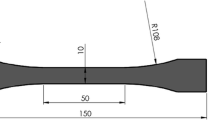Abstract
Modern lightweight concepts in the automotive industry are governed by the aim to reduce fuel consumption on the one hand, and by increasing requirements in terms of functionality such as crashworthiness, durability and driving performance on the other hand. Structural adhesive bonding in combination with high strength steels is one of the key tools in this effort. Crash durable, toughened epoxy adhesives are in the process of opening up new design possibilities to the automotive industry. A fundament of experimental data to describe the failure behaviour of toughened epoxy adhesives under different kinds of loads, as well as verified calculation concepts for the simulation of adhesive joints, are essential for the widespread usage of adhesive bonding as an economical, versatile joining technology suitable for meaningful structural usage. This paper presents experimental results with a one-component toughened epoxy adhesive under quasi static and crash loading, and achievements to simulate adhesively bonded components under crash loading. Furthermore, this article highlights and explains the importance of local force and displacement measurement on the specimens, since the machine rigidity and dynamic effects significantly influence the test data. This requires advanced testing machines and sophisticated measurement systems.
Similar content being viewed by others
References
Adam H., Osburg B., Patberg L., Grüneklee A., Floeth T., Hinz M.: NCB© NewSteelBody — Karosserieleichtbau mit Stahl, ThyssenKrupp techforum, 2004.
Symietz D.: Structural adhesive bonding: The most innovative joining technique for modern lightweight design, safety and modular concepts — progress report, SAE Technical Papers, Doc. number 2005-01–1747, 2004.
Flegel H.: The future of adhesive bonding as a joining technique, Auto Technolgy, 2002, Vol. 5, pp. 64–67.
Du Bois P.A., Kolling S., Koesters M., Frank T.: Material behaviour of polymers under impact loading, International Journal of Impact Engineering, 2006, Vol. 32, pp. 725–740.
Schlimmer M.: Grundlagen zur Berechnung des mechanischen Verhaltens von strukturellen Klebverbindungen des Fahrzeugbaus, 10. Paderborner Symposium Fuegetechnik — Mechanisches Fuegen und Kleben, Hahn O (ed.), Paderborn, 2003, pp. 107–133.
FOSTA — Forschungsvereinigung Stahlanwendung e.V.: Methodenentwicklung zur Berechnung von hoeherfesten Stahlklebverbindungen des Fahrzeugsbaus unter Crashbelastung, Project P676, ongoing research project, 2004–2007.
Bascom W.D., Hunston D.L.: Fracture of Elastomer-Modified Epoxy Polymers, Rubber Toughened Plastics, Ed. Riew, C.K., Advances in Chemistry Series 222, ISBN 0-8412-1488–3.
Hahn O., Gieske D.: Neue Einelementprobe zum Pruefen von Punktschweissverbindungen unter kombinierten Belastungen, Schweißen und Schneiden, 1994, Vol. 46, Nr. 1, pp. 9–12.
Hahn O., Rohde A., Gieske D.: Verfahren zur Herstellung von Proben und Probenspannvorrichtung, German Patent, Nr. 195 22 247, Patent holder: Hahn O., Muenchen, 1995.
Hahn O., Oeter M.: Beitrag zur Entwicklung einer Versuchsmethodik zur Bewertung des Crashverhaltens geklebter und hybridgefuegter Verbindungen, Bericht aus dem Laboratorium fuer Werkstoff- und Fuegtechnik der Universitaet Paderborn, 2005, Vol. 65, Shaker Verlag, Aachen.
ABAQUS Finite Element Program, Version 6.5; Hibbit, Karlson, Sorensen; Abaqus Inc. Providence, Rohde Island, USA, 2004.
Drucker D.C., Prager W.: Soil mechanics and plastic analysis or limit design, Quart Appl Math, 1952, Vol. 10, pp. 157–65.
Drucker D.C.: A definition of stable inelastic material, J Appl Mech, 1959, Vol. 26, pp. 101–6.
Hahn O., Disse T.: Untersuchungen zum geschwindigkeitsabhaengigen Festigkeits- und Verformungsverhalten von Klebverbindungen, Bericht aus dem Laboratorium fuer Werkstoff- und Fuegtechnik der Universitaet Paderborn, 2004, Vol. 61, Shaker Verlag, Aachen.
Author information
Authors and Affiliations
Rights and permissions
About this article
Cite this article
Wissling, M., Hahn, O. Adhesive Joints under Crash Loading: Experiments and Modelling of the Failure Behaviour. Weld World 51, 63–73 (2007). https://doi.org/10.1007/BF03266550
Published:
Issue Date:
DOI: https://doi.org/10.1007/BF03266550




